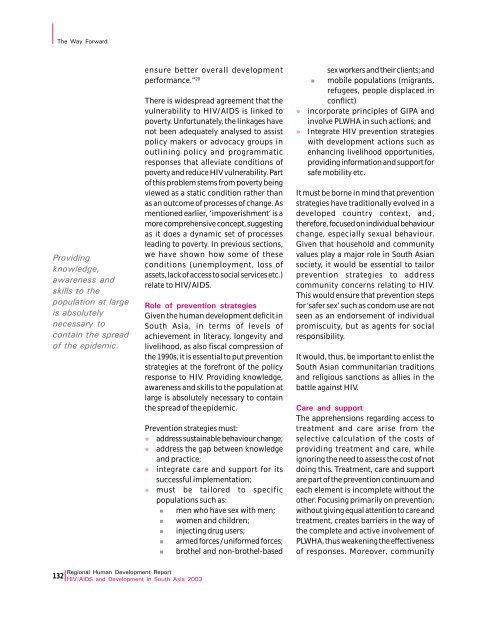Download Report - UNDP Asia-Pacific Regional Centre - United ...
Download Report - UNDP Asia-Pacific Regional Centre - United ...
Download Report - UNDP Asia-Pacific Regional Centre - United ...
Create successful ePaper yourself
Turn your PDF publications into a flip-book with our unique Google optimized e-Paper software.
The Way orwardProvidingknowledge,awareness andskills to thepopulation at largeis absolutelynecessary tocontain the spreadof the epidemic.ensure better overall developmentperformance.” 20There is widespread agreement that thevulnerability to HIV/AIDS is linked topoverty. Unfortunately, the linkages havenot been adequately analysed to assistpolicy makers or advocacy groups inoutlining policy and programmaticresponses that alleviate conditions ofpoverty and reduce HIV vulnerability. Partof this problem stems from poverty beingviewed as a static condition rather thanas an outcome of processes of change. Asmentioned earlier, ‘impoverishment’ is amore comprehensive concept, suggestingas it does a dynamic set of processesleading to poverty. In previous sections,we have shown how some of theseconditions (unemployment, loss ofassets, lack of access to social services etc.)relate to HIV/AIDS.Role of prevention strategiesGiven the human development deficit inSouth <strong>Asia</strong>, in terms of levels ofachievement in literacy, longevity andlivelihood, as also fiscal compression ofthe 1990s, it is essential to put preventionstrategies at the forefront of the policyresponse to HIV. Providing knowledge,awareness and skills to the population atlarge is absolutely necessary to containthe spread of the epidemic.Prevention strategies must:l address sustainable behaviour change;l address the gap between knowledgeand practice;l integrate care and support for itssuccessful implementation;l must be tailored to specificpopulations such as:n men who have sex with men;n women and children;n injecting drug users;n armed forces /uniformed forces;n brothel and non-brothel-basedllsex workers and their clients; andn mobile populations (migrants,refugees, people displaced inconflict)incorporate principles of GIPA andinvolve PLWHA in such actions; andIntegrate HIV prevention strategieswith development actions such asenhancing livelihood opportunities,providing information and support forsafe mobility etc.It must be borne in mind that preventionstrategies have traditionally evolved in adeveloped country context, and,therefore, focused on individual behaviourchange, especially sexual behaviour.Given that household and communityvalues play a major role in South <strong>Asia</strong>nsociety, it would be essential to tailorprevention strategies to addresscommunity concerns relating to HIV.This would ensure that prevention stepsfor ‘safer sex’ such as condom use are notseen as an endorsement of individualpromiscuity, but as agents for socialresponsibility.It would, thus, be important to enlist theSouth <strong>Asia</strong>n communitarian traditionsand religious sanctions as allies in thebattle against HIV.Care and supportThe apprehensions regarding access totreatment and care arise from theselective calculation of the costs ofproviding treatment and care, whileignoring the need to assess the cost of notdoing this. Treatment, care and supportare part of the prevention continuum andeach element is incomplete without theother. Focusing primarily on prevention,without giving equal attention to care andtreatment, creates barriers in the way ofthe complete and active involvement ofPLWHA, thus weakening the effectivenessof responses. Moreover, community<strong>Regional</strong> Human Development <strong>Report</strong>132 HIV/AIDS and Development in South <strong>Asia</strong> 2003
















